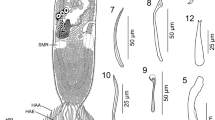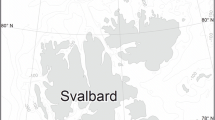Abstract
A new species of Echinoderes, E. applicitus sp. nov., is described from a brackish water lagoon on the south coast of Central Java, Indonesia. The species is recognized by its complete lack of spines on segments 1–10, lateroventral tubules on segments 5 and 8, laterodorsal tubules on segment 10, and a mid- to subdorsal tergal protrusion of segment 10 that extends beyond the posterior margin of segment 11. The general reduction of spine size and numbers, the absence of lateral terminal accessory spines in females and the enlarged sieve plate suggest a close relationship with E. rex, E. coulli, E. maxwelli and E. teretis. The adaptation to a brackish, estuarine habitat with highly fluctuating salinities is also shared between the three latter species and E. applicitus sp. nov. The examined populations of the new species had a relatively high infection rate (10–15%) of epibiontic growth from at least three different prokaryotic or protist organisms. An infection rate of this magnitude has not previously been reported for kinorhynchs, and it may have a relationship to the brackish habitat.






Similar content being viewed by others
Notes
During the revision of the present manuscript, the senior author learned through a personal communication from H. Yamasaki and H. Kajihara that one additional psammic, intertidal species of Echinoderes is currently being described, and that the species shows great morphological resemblance with E. coulli, E. maxwelli, E. teretis, and E. applicitus sp. nov.
References
Ardli ER, Wolff M (2009) Land use and land cover change affecting habitat distribution in the Segara Anakan lagoon, Java, Indonesia. In: Jennerjahn TC, Yuwono E (eds) Segara Anakan, Java, Indonesia, a mangrove-fringed coastal lagoon affected by human activities. Reg Environ Change, special issue 6:235–243
Brown R (1985) Developmental and taxonomic studies of Sydney Harbour Kinorhyncha. Dissertation, Macquarie University, Australia
Brown R, Higgins RP (1983) A new species of Kinorhynchus (Homalorhagida, Pycnophyidae) from Australia with a redescription and range extension of other Kinorhyncha from the South Pacific. Zool Scr 12:161–169
Dsikowitzky L, Nordhaus I, Jennerjahn TC, Khrycheva P, Sivatharshan Y, Yuwono E, Schwarzbauer J (2011) Anthropogenic organic contaminants in water, sediments and benthic organisms of the mangrove-fringed Segara Anakan Lagoon, Java. Indonesia Mar Pol Bull 62:851–862
GaOrdóñez D, Pardos F, Benito J (2008) Three new Echinoderes (Kinorhyncha, Cyclorhagida) from North Spain, with new evolutionary aspects in the genus. Zool Anz 247:95–111
Gwyther D, Batterham GJ, Waworuntu J, Gultom TH, Prayogo W, Susetiono K (2009) Recolonisation of mine tailing by meiofauna in mesocosm and microcosm experiments. Mar Pol Bull 58:841–850
Hauton C, Hawkins LE, Hutchinson S (2000) The effects of salinity on the interaction between a pathogen (Listonella anguillarum) and components of a host (Ostrea edulis) immune system. Comp Biochem Phys B 127:203–212
Herranz M (2009) Caracterización morfológica de los kinorrincos ciclorrágidos de la Costa Mediterránea Española. Master thesis, Universidad Complutense de Madrid
Higgins RP (1967) The Kinorhyncha of New-Caledonia In: Expedition Française sur Recifs Coralliens de la Nouvelle. Caledonia 2:75–90
Higgins RP (1977) Two new species of Echinoderes (Kinorhyncha) from South Carolina. Trans Am Microsc Soc 96:340–354
Higgins RP, Fleeger JW (1980) Seasonal changes in the population structure of Echinoderes coulli (Kinorhyncha). Estuar Coast Mar Sci 10:495–505
Higgins RP, Rao GC (1979) Kinorhynchs from the Andaman Islands. Zool J Linn Soc 67:75–85
Hinrichs S, Nordhaus I, Geist SJ (2009) Status, diversity and distribution patterns of mangrove vegetation in the Segara Anakan lagoon, Java, Indonesia. In: Jennerjahn TC, Yuwono E (eds) Segara Anakan, Java, Indonesia, a mangrove-fringed coastal lagoon affected by human activities. Reg Environ Change, special issue 9:275–289
Holtermann P, Burchard H, Jennerjahn T (2009) Hydrodynamics of the Segara Anakan lagoon. In: Jennerjahn TC, Yuwono E (eds) Segara Anakan, Java, Indonesia, a mangrove-fringed coastal lagoon affected by human activities. Reg Environ Change, special issue 9: 245–258
Horn TD (1978) The distribution of Echinoderes coulli (Kinorhyncha) along an interstitial salinity gradient. Trans Am Microsc Soc 97:586–589
Karling TG (1954) Echinoderes levanderi n. sp. (Kinorhyncha) aus der Ostsee. Arkiv Zool 7:189–192
Kristensen RM, Higgins RP (1991) Kinorhyncha. In: Harrison FW, Ruppert EE (eds) Microscopic anatomy of invertebrates, vol 4, The Aschelminthes. Wiley-Liss, New York, pp 377–404
Lemburg C (2002) A new kinorhynch Pycnophyes australensis sp. n. (Kinorhyncha: Homalorhagida: Pycnophyidae) from Magnetic Island, Australia. Zool Anz 241:173–189
Lundbye H, Rho HS, Sørensen MV (2011) Echinoderes rex n. sp. (Kinorhyncha: Cyclorhagida), the largest Echinoderes species found so far. Sci Mar 75:41–51
McIntyre AD, Warwick RM (1984) Meiofauna techniques. In: Holme NA, McIntyre AD (eds) Methods for the Study of Marine Benthos, 2nd edn. Blackwell, Oxford, pp 217–244
Nebelsick M (1992) Sensory spots of Echinoderes capitatus (Zelinka, 1928) (Kinorhyncha, Cyclorhagida). Acta Zool 73:185–195
Neuhaus B, Higgins RP (2002) Ultrastructure, biology and phylogenetic relationships of Kinorhyncha. Integ Comp Biol 42:619–632
Omer-Cooper J (1957) Deux nouvelle especes de Kinorhyncha en provenance de L´Afrique du Sud. Bull Mens Soc Linn Lyon 26:213–216
Pardos F, Higgins RP, Benito J (1998) Two new Echinoderes (Kinorhyncha, Cyclorhagida) including a reevaluation of kinorhynch taxonomic characters. Zool Anz 237:195–208
Paterson KJ, Schreider M, Zimmermann KD (2003) Effect of catchment disturbance on seston quality and quantity in Brisbane Water, NSW. Estuar Coast Shelf Sci 56:355–368
Reimer L (1963) Zur Verbreitung der Kinorhyncha in der mittleren Ostsee. Zool Anz 171:440–447
Sørensen MV, Pardos F (2008) Kinorhynch systematics and biology – an introduction to the study of kinorhynchs, inclusive identification keys to the genera. Meiofauna Mar 16:21–73
Sørensen MV, Thormar J (2010) Wollunquaderes majkenae gen. et sp. nov. - a new cyclorhagid kinorhynch genus and species from the Coral Sea, Australia. Mar Biodiv 40:261–275
Sørensen MV, Jørgensen A, Boesgaard TM (2000) A new Echinoderes (Kinorhyncha: Cyclorhagida) from a submarine cave in New South Wales, Australia. Cah Biol Mar 41:167–179
Thormar J, Sørensen MV (2010) Two new species of Echinoderes (Kinorhyncha: Cyclorhagida) from the Solomon Islands. Meiofauna Mar 18:67–96
Veit-Koehler G, Laudien J, Knott J, Velez J, Sahade R (2008) Meiobenthic colonization of soft sediments in Arctic glacial Kongsfjorden (Svalbard). J Exp Mar Biol Ecol 363:58–65
Wang L-U, Cheng J-C (2005) The immune response of white shrimp Litopenaeus vannamei and its susceptibility to Vibrio alginolyticus at different salinity levels. Fish Shellfish Immun 18:269–278
Zelinka C (1928) Monographie der Echinodera. Wilhelm Engelmann, Leipzig
Acknowledgements
We wish to thank Pedro Arbizu Martinez for valuable discussions and for offering research facilities at the Senckenberg Institute at Wilhelmshaven, Yully Atikasari and Flandrianto Sihp for their assistance during the field work, Tom Fenchel for his comments regarding identity of the epibionts, and Stine Elle for providing the line art illustrations. This work has been conducted with funding from the DAAD (Deutscher Akademischer Austausch Dienst) that supported the first author’s field work on Java (Grant No. D0945941). The SPICE project was funded by the German Federal Ministry for Education and Research (Grant No. 03F0471A) and it is gratefully acknowledged. Funding was furthermore granted from the Danish Natural Science Research Council (Grant No. 09–066003) to M.V.S.
Author information
Authors and Affiliations
Corresponding author
Rights and permissions
About this article
Cite this article
Ostmann, A., Nordhaus, I. & Sørensen, M.V. First recording of kinorhynchs from Java, with the description of a new brackish water species from a mangrove-fringed lagoon. Mar Biodiv 42, 79–91 (2012). https://doi.org/10.1007/s12526-011-0094-z
Received:
Revised:
Accepted:
Published:
Issue Date:
DOI: https://doi.org/10.1007/s12526-011-0094-z




